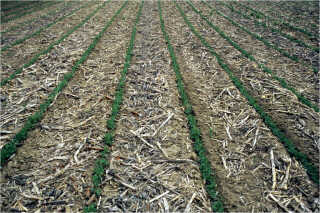No-Till November? Is that like No Shave November? Yes and no. The Natural Resources Conservation Service is asking farmers to keep your stubble – out in the fields, that is. NRCS is encouraging South Dakota farmers to “keep the stubble” on their harvested crop fields and improve soil health during No-Till November.

First launched in 2017, the NRCS project is, of course, mirrored after the national cancer awareness No Shave November campaign that encourages people not to shave during the entire month. The NRCS campaign encourages farmers to keep tillage equipment in their machine sheds this fall and keep the crop stubble on their fields.
The campaign has reached more than 1.5 million people through Twitter and local media since 2017.
“No-till farming is a cornerstone soil health conservation practice, which also promotes water quality while saving farmers time and money,” said South Dakota NRCS State Conservationist Jeff Zimprich. “One of the first soil health principles is ‘do not disturb’. This campaign is a fun way to remind farmers about the important relationship between tillage and soil health. Utilizing cover crops and leaving residues on the soil surface improve soil health while increasing soil biological activity, providing erosion control and adding beneficial nutrients.”
 Terry Ness has been farming in central South Dakota for 42 years. He describes the changes he and his wife Mary have made to improve their soil health helped to give their soils more resilience. After utilizing tillage for the first 14 years of his career, he switched completely to a no-till system and noticed that many challenges became easier to overcome. To see Terry and Mary’s full Profile in Soil Health video feature, visit: bit.ly/TerryNess.“With all these good things I’m doing, you can see it in the insect population, the bird population – healthy soil makes healthy animals, makes healthy food – all this ties together.” – Terry Ness More InformationTo learn more about soil health and no-till in South Dakota, visit your nearest NRCS service center, visit bit.ly/contactnrcssd, or ask questions from a local soil health mentor! E-mail Rachel.Giles@usda.gov to receive a digital copy of the “Building Connections” SD soil health mentor network directory, or have one mailed to you at no cost. |

